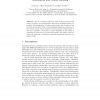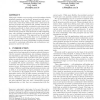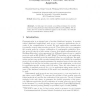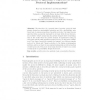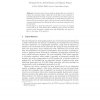ISLPED
2003
ACM
14 years 8 months ago
2003
ACM
Security is critical to a wide range of wireless data applications and services. While several security mechanisms and protocols have been developed in the context of the wired In...
ESORICS
2004
Springer
14 years 8 months ago
2004
Springer
The use of formal methods to verify security protocols with respect to secrecy and authentication has become standard practice. In contrast, the formalization of other security goa...
SENSYS
2004
ACM
14 years 8 months ago
2004
ACM
We introduce TinySec, the first fully-implemented link layer security architecture for wireless sensor networks. In our design, we leverage recent lessons learned from design vul...
NSPW
2004
ACM
14 years 8 months ago
2004
ACM
This paper considers a new security protocol paradigm whereby principals negotiate and on-the-fly generate security protocols according to their needs. When principals wish to in...
ESORICS
2005
Springer
14 years 8 months ago
2005
Springer
Currently, many industrial initiatives focus on web-based applications. In this context an important requirement is that the user should only rely on a standard web browser. Hence...
ASM
2005
ASM
14 years 8 months ago
2005
ASM
In this paper we present a modeling technique for security protocols using Abstract State Machines [BS03,Gur95] (ASMs). We describe how we model the different agents in the scenar...
BROADNETS
2005
IEEE
14 years 8 months ago
2005
IEEE
- In this paper, we study and quantify the impact of the most widely used security protocols, such as 802.1x, EAP, IPSEC, SSL and RADIUS, in wireless local area networks (WLANs). B...
IEEEARES
2006
IEEE
14 years 9 months ago
2006
IEEE
Formal modeling and verification of security protocols typically assumes that a protocol is executed in isolation, without other protocols sharing the network. We investigate the...
TARK
2007
Springer
14 years 9 months ago
2007
Springer
We introduce (i) a general class of security protocols with private channel as cryptographic primitive and (ii) a probabilistic epistemic logic to express properties of security pr...
FSTTCS
2007
Springer
14 years 9 months ago
2007
Springer
Security protocols are small programs that are executed in hostile environments. Many results and tools have been developed to formally analyze the security of a protocol. However ...

